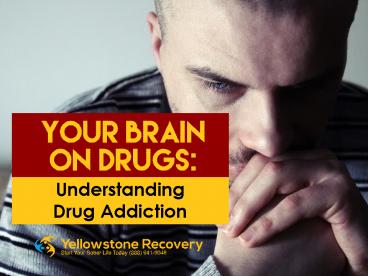Your Brain on Drugs: Understanding Drug Addiction - PowerPoint PPT Presentation
Title:
Your Brain on Drugs: Understanding Drug Addiction
Description:
Drugs impact people in different ways and some have a stronger or more immediate detrimental impact than others. Despite the hold that drugs take over a person and the lasting physiological effects they have on the brain, treatment is possible. Utilizing a treatment facility is one way to receive the concentrated rehabilitation efforts that make recovery possible. – PowerPoint PPT presentation
Number of Views:421
Title: Your Brain on Drugs: Understanding Drug Addiction
1
Understanding Drug Addiction
2
- The brains many parts coordinate and perform all
of the functions that make our daily lives
possible. When drugs are introduced, they alter
important life-sustaining functions and can drive
the compulsive drug abuse that leads to
addiction. - The primary areas of the brain affected by drug
use are - the brain stem, which controls basic functions
critical to life such as breathing and heart
rate - the cerebral cortex, which controls our senses
and ability to think, plan, and solve problems
and - the limbic system, which controls and regulates
our ability to feel pleasure. - Understanding how drugs affect the brain leads to
understanding addiction and how addiction can be
treated.
3
- Drugs tap into the brains communication system
and interfere with how neurons send, receive, and
process information. Almost all drugs that change
the way the brain works do so by affecting
chemical neurotransmission. For example - Heroin and LSD mimic the effects of a natural
neurotransmitter. - PCP blocks receptors and thus prevents neuronal
messages from getting through. - Cocaine interferes with the molecules that are
responsible for transporting neurotransmitters
back into the neurons that released them. - Methamphetamine causes neurotransmitters to be
released in greater amounts than normal. - Prolonged drug use changes the brain in
fundamental and long-lasting ways.
4
- Life sustaining activities, such as eating,
activate a circuit of specialized nerve cells
devoted to producing and regulating pleasure. One
set of these nerve cells uses a chemical
neurotransmitter called dopamine. - Dopamine regulates movement, emotion, motivation,
and feelings of pleasure. Most abused drugs
target the brains reward system by flooding the
circuit with dopamine. - In a person who does not abuse drugs, this reward
system is activated at normal levels making a
person feel good when performing natural
behaviors. In a person abusing drugs, it is
highly over-stimulated and produces extremely
euphoric effects.
5
- The brain compensates for the excessive amount of
dopamine received during drug use by reducing the
number of dopamine receptors, to dampen the
response, and increasing the number of dopamine
transporters that clear out the dopamine. - As a result, the brain is less responsive to a
drug, and next time, a drug user will have a
higher tolerance and will need more of the drug
to get high. - As another consequence, the pleasure received
from performing natural behaviors is severely
diminished to the point of being barely
noticeable. Drugs become necessary just to bring
dopamine function back to normal.
6
- Addiction is also a consequence of behavioral
conditioning. When your brain is accustomed to
the idea that doing something will provide
pleasure, such as eating dessert, just seeing a
dessert or thinking about dessert will trigger a
dopamine response. - This is partly why it is difficult for drug
addicts to stay sober. There are so many sights,
sounds, and smells associated with getting high
that make them want to fulfill the urge and get
the actual high.
7
- More of the drug is needed to experience the same
effects that were once associated with smaller
amounts. - Drugs are used to avoid or relieve withdrawal
symptoms such as nausea, restlessness, insomnia,
depression, sweating, shaking, and anxiety. - Drug use is no longer controllable and is in
excess of what was planned. - A lot of time is spent using and thinking about
drugs, figuring out how to get drugs, and
recovering from the drugs effects. - Enjoyable hobbies, sports, and socializing are no
longer participated in. - Despite major harm and problems, such as
blackouts, infections, mood swings, depression,
and paranoia, drugs are still used.
8
- Drug addiction risk is influenced by biology,
social environment, and the age or stage of
development. The more risk factors a person has,
the more likely theyll develop addiction. - Biology The genes that people are born with
combined with environmental influences accounts
for about half of addiction vulnerability.
Additionally, gender, ethnicity, and the presence
of other mental disorders may influence risk. - Environment A persons environmental influences
include family, friends, socioeconomic status,
and quality of life in general. Factors such as
peer pressure, physical or sexual abuse, stress,
and quality of parenting can also greatly
influence the occurrence of drug abuse. - Development Genetic and environmental factors
interact with critical developmental stages in a
persons life to affect addiction vulnerability.
Although taking drugs at any age can lead to
addiction, the earlier that drug use begins, the
more likely it will progress to more serious
abuse.
9
- Recovery is never out of reach, no matter how
hopeless a situation seems. Change is possible
with the right treatment and support and by
addressing the root cause of the addiction.
Support is essential and can be received in an
inpatient or outpatient treatment facility. - Recovering from drug addiction is much easier
when a person has people to lean on for
encouragement, comfort, and guidance. After the
initial detoxification, which can be aided with
medication to suppress withdrawal symptoms, drug
treatment can include individual and group
treatment with peers for a concentrated and
extended period of time.
10
- Yellowstone Recovery has been helping people
break free from drugs and alcohol for over 15
years and offers Southern Californians affordable
treatment options, including detoxification,
inpatient care, extended inpatient care, and
outpatient care. - Website http//www.yellowstonerecovery.com
- Phone (888) 904-3520































